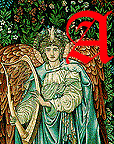His importance lies not only in his virtual creation of the major style of the l9th century, Neo-Gothic, which was a fundamental re-creation and not a pastiche, but in his deliberate approach to design and function. Pugin anticipated many of Ruskin's statements on design in the many books and pamphlets that he wrote. Just before his death, he was in charge of the Medieval Court in the Great Exhibition of 1851, and also served on the committee which selected objects to be purchased from the Exhibition for the new Museum of Manufactures. — Collins Encylcopedia.
 ugustus Welby Pugin, the architect, designer, writer, and theorist, was born in London on 1 March 1812. He had an enormous influence upon architecture and design throughout the English-speaking world well into this century. He studied with his father, the French-born architect Auguste Charles Pugin (1762-1832). Pugin, who favored the revival of fourteenth-century gothic, attempted to create entire coherent, consistent architectural and interior environments in this style, and by designing an entire "range of interior fittings," he attempted "to express entire schemes of design in Gothic terms, rather than employ Gothic architectural details as means of decorationa" (Collins Encylcopedia).
ugustus Welby Pugin, the architect, designer, writer, and theorist, was born in London on 1 March 1812. He had an enormous influence upon architecture and design throughout the English-speaking world well into this century. He studied with his father, the French-born architect Auguste Charles Pugin (1762-1832). Pugin, who favored the revival of fourteenth-century gothic, attempted to create entire coherent, consistent architectural and interior environments in this style, and by designing an entire "range of interior fittings," he attempted "to express entire schemes of design in Gothic terms, rather than employ Gothic architectural details as means of decorationa" (Collins Encylcopedia).
According to Rowland Elzea, "when only fifteen [he] was designing silverware in the Gothic style for the Royal Goldsmiths, Rundell, Bridge, and Rundell, and furniture for Morel and Seddon, who were then supplying furniture for the redecoration of Windsor Castle. He first set up on his own in 1830 with a small workshop specialising in furniture, but this was not successful. . ." After a series of deaths in his family, including his young wife, his father and mother, and his aunt, who left him a small inheritance, he decided to turn his talents to architecture, became a Catholic, and spent time travelling in England and abroad, studying Gothic architecture and design.
In 1835 he remarried and started his architectural career. In 1836 and 1837 and again in 1844 and 1852 he worked with Charles Barry on the designs for the new Houses of Parliament with responsibility for designing all the ornamental detail, and probably also the execution of the working drawings. From 1837 until his death, he designed many churches and houses as well as designing their furnishings. He was a prolific designer of stained glass, metalwork, furniture, textiles, wallpapers, ceramics, embroideries, and jewellery.
After his conversion to Roman Catholicism in 1835, he published Contrasts (1836), which argued that since gothic was an expression of a Roman Catholic society, only such a society could produce true gothic -- a position that he continued to expound in True Principles of Pointed Architecture published 1841. According to a leading historian of architecture, by thus imbuing architecture with ideology, Pugin created the "Victorian dilemma of style."
The Collins Encyclopedia points out that although his "furniture for private houses [was] often simple, with restrained, carved decoration, naturalistic, flat-patterned coloured inlays," he also produced more elaborate gothic pieces, such as those for the Medieval Courts at the 1851 exhibition, which were "decorated with delicate tracery, cresting, and heraldic devices."
Much of his influence in design came after his death on 14 September 1852 (the same day as the Duke of Wellington's) "as a result of elaborate carved furniture made in his idiom by J. G. Crace & Sons, with whom he had collaborated in design of wallpapers, fabrics, and schemes of decoration." J. Hardman & Co., a Birmingham firm, created ecclesiastical metalwork following his designs, thereby extending his influence. Pugin also created the "pattern for English Gothic jewellery and revived use of enamelling as integral part of design; influenced ecclesiastical and other jewellery." Finally, his "rigorous insistence on consistent, historically accurate" fourtheenth-century style proved an important influence on Victorian craftsmanship in many fields, including in furniture, metalwork, and jewellery.
References
Collins Collector's Encylopedia: Victoriania to Art Deco, The. Edited by Ian Cameron, Elizabteh Kingsley-Rowe, Halina Tunikowska, Christopher Fagg, and Bettina Tayleur. New York: Random House, 1974. Appeared in American edition as Random House Collector's Encylopedia.
Elzea, Rowland and Betty. The Pre-Raphaelite Era, 1848-1914. Wilmington, Delaware Art Museum, 1976.
Ferrey, Benjamin. Recollections of A. N. W. Pugin and His Father Augustus Pugin. with Notices of their Works. London: Stanford, 1861.
Gwynn, Denis R. Lord Shrewsbury, Pugin, and the Catholic Revival. London: Hollins and Carter, 1946.
Stanton, Phoebe B. The Gothic Revival and American Church Architecture: An Episode in Taste, 1840-1856. Baltimore: The Johns Hopkins Press, 1968.
Trappes-Lomax, M. , Pugin. a Medieval Victorian. London: Sheed and Ward, 1932.
Last modified December 1999